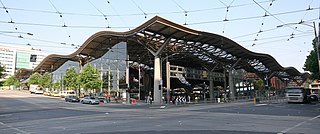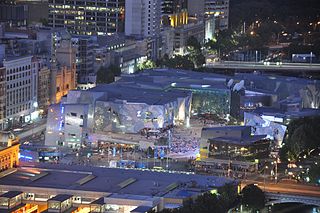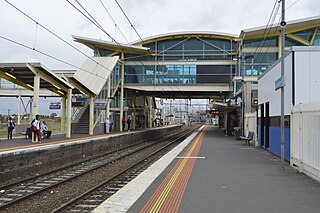
Flinders Street railway station is located on the corner of Flinders and Swanston streets in the central business district (CBD) of Melbourne, Victoria, Australia. Opened in 1854, the historic station serves the entire metropolitan rail network, as well as some country services to eastern Victoria. Backing onto the Yarra River in the heart of the city, the complex includes platforms and structures that stretch over more than two whole city blocks, from east of Swanston Street nearly to Market Street.

Southern Cross railway station is a major railway station in Docklands, Melbourne. It is on Spencer Street, between Collins and La Trobe Streets, at the western edge of the Melbourne central business district. The Docklands Stadium sports arena is 500 metres north-west of the station.

Federation Square is a venue for arts, culture and public events on the edge of the Melbourne central business district. It covers an area of 3.2 ha at the intersection of Flinders and Swanston Streets built above busy railway lines and across the road from Flinders Street station. It incorporates major cultural institutions such as the Ian Potter Centre, Australian Centre for the Moving Image (ACMI) and the Koorie Heritage Trust as well as cafes and bars in a series of buildings centred around a large paved square, and a glass walled atrium.

The City Loop is a mostly-underground and partly surface-level subway and rail system in the central business district (CBD) of Melbourne, Victoria, Australia.

Camberwell railway station is the junction station for the Lilydale, Belgrave and Alamein lines in Victoria, Australia. It serves the eastern Melbourne suburb of Camberwell, and it opened on 3 April 1882.

Caulfield railway station is the junction station for the Pakenham, Cranbourne and Frankston lines in Victoria, Australia. It serves the south-eastern Melbourne suburb of Caulfield East, and opened on 7 May 1879.

Cheltenham railway station is located on the Frankston line in Victoria, Australia. It serves the south-eastern Melbourne suburb of Cheltenham, and it opened on 19 December 1881.

Dandenong railway station is the junction station for the Pakenham and Cranbourne lines in Victoria, Australia. It serves the south-eastern Melbourne suburb of Dandenong, and it opened on 8 October 1877.

North Melbourne railway station is the junction station for the Craigieburn, Flemington Racecourse, Sunbury, Upfield, Werribee and Williamstown lines in Victoria, Australia. It serves the inner-city Melbourne suburb of West Melbourne, and opened on 6 October 1859.

Jewell railway station is located on the Upfield line in Victoria, Australia. It serves the northern Melbourne suburb of Brunswick, and it opened on 9 September 1884 as South Brunswick. It was renamed Jewell on 1 February 1954.

Footscray railway station is the junction station for the Sunbury, Werribee and Williamstown lines in Victoria, Australia. It serves the western Melbourne suburb of Footscray, and it opened on 17 January 1859.

Rushall railway station is located on the Mernda line in Victoria, Australia. It serves the north-eastern Melbourne suburb of Fitzroy North, and it opened on 1 January 1927.

Bourke Street is one of the main streets in the Melbourne central business district and a core feature of the Hoddle Grid. It was traditionally the entertainment hub of inner-city Melbourne, and is now also a popular tourist destination and tram thoroughfare.

Melbourne Central railway station is an underground station on the electrified railway network in Melbourne, Australia. It is one of five stations on the City Loop, which encircles the Melbourne CBD. The station is located under La Trobe Street, between Swanston and Elizabeth Streets, on the northern edge of the central business district (CBD). The station is named after the Melbourne Central Shopping Centre, which it is beneath. It feeds into Melbourne's main metro network station, Flinders Street, and also Southern Cross, Melbourne's main regional terminus. In 2017/2018, it was the third-busiest station on the Melbourne metropolitan rail network, with 15.859 million passenger movements.

Elizabeth Street is one of the main streets in the central business district of Melbourne, Victoria, Australia, part of the Hoddle Grid laid out in 1837. It is presumed to have been named in honour of governor Richard Bourke's wife.

Centre Place is a laneway and pedestrian precinct in Melbourne, Australia. It runs north from Flinders Lane to Collins Street, between Elizabeth Street and Swanston Street.

Degraves Street is a pedestrian precinct and thoroughfare in Melbourne, Victoria, Australia. It is a short, narrow laneway in the Central Business District that runs north–south from Flinders Street to Flinders Lane and is situated in-between Swanston Street and Elizabeth Street. Degraves, as the street is colloquially known, is famous for its alfresco dining options and because it epitomises Melbourne's coffee culture and street art scene. For these reasons it has also become a popular tourist destination.

Platform Artists Group Inc. or Platform Contemporary Art Spaces, commonly known as Platform, is one of Australia's longest operating artist-run initiative. The organisation develops exhibitions of visual arts by artists from Australia and around the world. Platform primarily consists of 3 separate spaces, all located in and under the busy Flinders Lane precinct in the heart of Melbourne city.

The Melbourne central business district in Australia is home to numerous lanes and arcades. Often called "laneways", these narrow streets and pedestrian paths date mostly from the Victorian era, and are a popular cultural attraction for their cafes, bars and street art.

The architecture of Melbourne, the capital of the state of Victoria and second most populous city in Australia, is characterised by a wide variety of styles dating from the early years of European settlement to the present day. The city is particularly noted for its mix of Victorian architecture and modern buildings, with 52 skyscrapers in the city centre, the most of any city in the Southern Hemisphere.





















